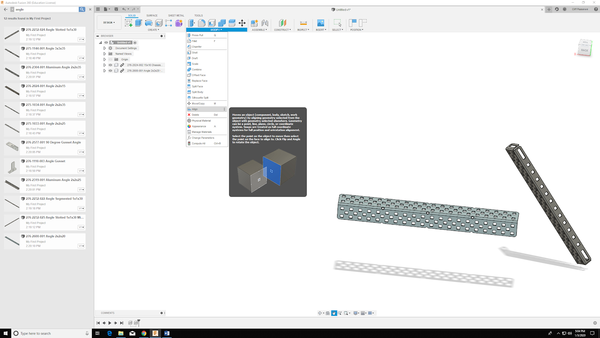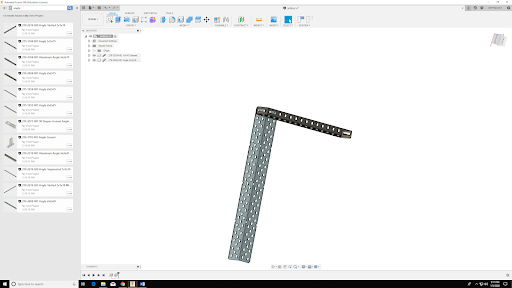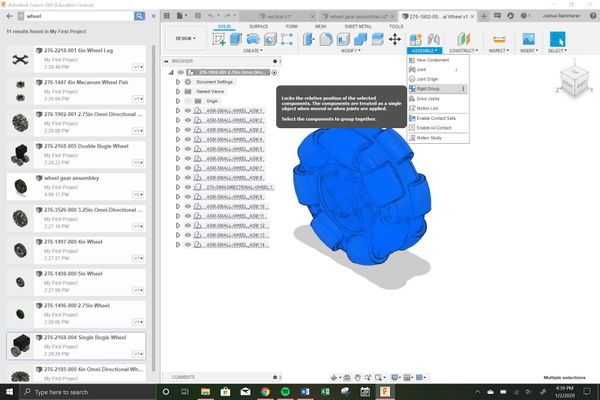Difference between revisions of "VEX CAD Assembly Guide"
| Line 27: | Line 27: | ||
# The VEX parts will take a few minutes to upload from your files to Fusion 360. Once the upload is complete, click Close in the Job Status window. There should be new files in the Data Panel. You can double click one of the files to open the VEX part, or click and drag the files into your project to use them for the assembly | # The VEX parts will take a few minutes to upload from your files to Fusion 360. Once the upload is complete, click Close in the Job Status window. There should be new files in the Data Panel. You can double click one of the files to open the VEX part, or click and drag the files into your project to use them for the assembly | ||
== | == Creating the Assembly == | ||
In CAD, an <b>assembly</b> is a group of individual components that are aligned to each other using mating conditions. Mating conditions are the relative positions of components in respect to each other. Individual components usually require multiple mating conditions to become fully defined in 3D space. In Fusion 360, there are a few functions to generate mating conditions, specifically the Align tool, Joint tool, and Rigid Group tool. | |||
=== Aligning === | |||
Note: Connecting pieces are screws, rods, shaft collars, wheels, etc. | |||
# Move the two bodies being aligned close to one another using the Move tool (Figure 1) | |||
[[File:VEX_CAD_Assembly_Guide_media_2.png|600px|thumb|center|Figure 1: Move tool]] | [[File:VEX_CAD_Assembly_Guide_media_2.png|600px|thumb|center|Figure 1: Move tool]] | ||
*Select the Modify tab from the Design workspace (Figure 3) | *Select the Modify tab from the Design workspace (Figure 3) | ||
[[File:VEX_CAD_Assembly_Guide_media_4.png|600px|thumb|center|Figure 3: Menu Dropdown]] | [[File:VEX_CAD_Assembly_Guide_media_4.png|600px|thumb|center|Figure 3: Menu Dropdown]] | ||
| Line 44: | Line 41: | ||
*Repeat steps 3-5 using different points of the bodies being aligned until they are oriented as desired (Figure 4) | *Repeat steps 3-5 using different points of the bodies being aligned until they are oriented as desired (Figure 4) | ||
[[File:VEX_CAD_Assembly_Guide_media_5.png|600px|thumb|center|Figure 4: Aligned Bodies]] | [[File:VEX_CAD_Assembly_Guide_media_5.png|600px|thumb|center|Figure 4: Aligned Bodies]] | ||
=== Rigid Bodies === | |||
# Note that components like the wheels are already files consisting of two bodies. They will have to be joined as a Rigid Group prior to adding additional components | |||
**To make a rigid group: | |||
***Highlight all bodies of the subject component | |||
***Go to the Assemble tab and click Rigid Group (Figure 2). If prompted that components have been moved, select “Capture Position.” | |||
[[File:VEX_CAD_Assembly_Guide_media_3.png|600px|thumb|center|Figure 2: Rigid Group tool]] | |||
== Shortcut to Replicating Sub-Assemblies == | == Shortcut to Replicating Sub-Assemblies == | ||
Revision as of 20:06, 24 January 2020
Goals for this Guide
- Be able to troubleshoot common CAD problems
- Design and implement CAD drawings in Fusion 360 for a VEX robot
Disclaimer
Please thoroughly read the entire guide before starting your Fusion 360 assembly. There are some tips that will make creating your model much easier. Also, keep in mind it might take more than three Aligns to get your parts to snap into place at first, but once you complete a few and start to become comfortable with it, it should become faster. If you have any questions, feel free to ask a TA.
Preparation of Software
Invite to Collaborate in Fusion 360
- Download Fusion 360 from the Autodesk website
- Create an account with your NYU email or sign in
- Once downloaded, open Fusion 360
- In the top left corner of the window, click the Data Panel icon (Figure 1) File:VEX CAD Assembly Guide Media 2.pngFigure 1: Data Panel Icon
- In the Data Panel, click New Project. Name your project and press the Enter key
- Double click on the box with your project name. Go to the People tab at the top of the page
- Enter the email addresses of your teammates and click the Invite button
Download and Import VEX Parts
- Download the Autodesk VEX Kit of Parts (KoP). Make sure to download the Fusion 360 KoP for VEX EDR
- Extract the downloaded ZIP folder (Figure 2)
- In Fusion 360, go to the Data tab of your project and click New Folder. Name the new folder and press the Enter key. This folder will contain all the downloaded VEX parts for the project
- Double click the new folder that was just created. Click the Upload button
- In the dialog that just appeared, click Select Files
- In the File Explorer, navigate to the unzipped folder of VEX parts
- For Mac users, select the _MACOSX folder. For Windows users, select the Fusion_360_VEX_EDR_KOP folder. Select all the individual F3Z files in each folder to download. You can select all the F3Z files in individual folders but cannot select F3Z files from different folders. Select the files you believe you will need for your project. Click Open
- In the window that appears, click Upload
- The VEX parts will take a few minutes to upload from your files to Fusion 360. Once the upload is complete, click Close in the Job Status window. There should be new files in the Data Panel. You can double click one of the files to open the VEX part, or click and drag the files into your project to use them for the assembly
Creating the Assembly
In CAD, an assembly is a group of individual components that are aligned to each other using mating conditions. Mating conditions are the relative positions of components in respect to each other. Individual components usually require multiple mating conditions to become fully defined in 3D space. In Fusion 360, there are a few functions to generate mating conditions, specifically the Align tool, Joint tool, and Rigid Group tool.
Aligning
Note: Connecting pieces are screws, rods, shaft collars, wheels, etc.
- Move the two bodies being aligned close to one another using the Move tool (Figure 1)
- Select the Modify tab from the Design workspace (Figure 3)
- From the dropdown select Align
- Select the first surface being aligned
- The first surface selected will be snapped to the second surface selected
- Repeat steps 3-5 using different points of the bodies being aligned until they are oriented as desired (Figure 4)
Rigid Bodies
- Note that components like the wheels are already files consisting of two bodies. They will have to be joined as a Rigid Group prior to adding additional components
- To make a rigid group:
- Highlight all bodies of the subject component
- Go to the Assemble tab and click Rigid Group (Figure 2). If prompted that components have been moved, select “Capture Position.”
- To make a rigid group:
Shortcut to Replicating Sub-Assemblies
In some instances, such as for the wheels, it will be required to align gears with the wheel before aligning the sub-assembly with your frame. Seeing that most designs have four wheels, repeating the process multiple times over can become tedious and time-consuming. Using the method below, sub-assemblies can be joined as one body and copied as many times as needed:
- Open a new file to begin the sub-assembly
- Save the newly created file inside the same folder as all the vex parts
- Drag in desired components
- Under the Modify tab, select Align.
- The body selected first will be the body that is moved
- Select a face or edge on the second body to align with the first body.
- Repeat alignment steps for the two remaining axes to complete the alignment process
- Save the file in the same folder as all the downloaded Vex components
- Now you can drag newly made rigid group into the main robot assembly as many times as needed
Using this process whenever there are repeated components will greatly reduce the time needed to make the full assembly.




